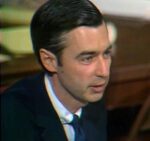His computer-generated voice has become familiar to generations of people, instantly garnering recognition as the words of a genius. His name is uttered in the same breath as Einstein and Galileo and yet few people can understand the complexities of his theories. What they do know is that Stephen Hawking overcame physical obstacles that would have defeated many to pursue his passions. In the process he became an inspiration to millions and added greatly to our understanding of the universe. In this week’s Biographics, we undertake a brief history of Stephen Hawking.
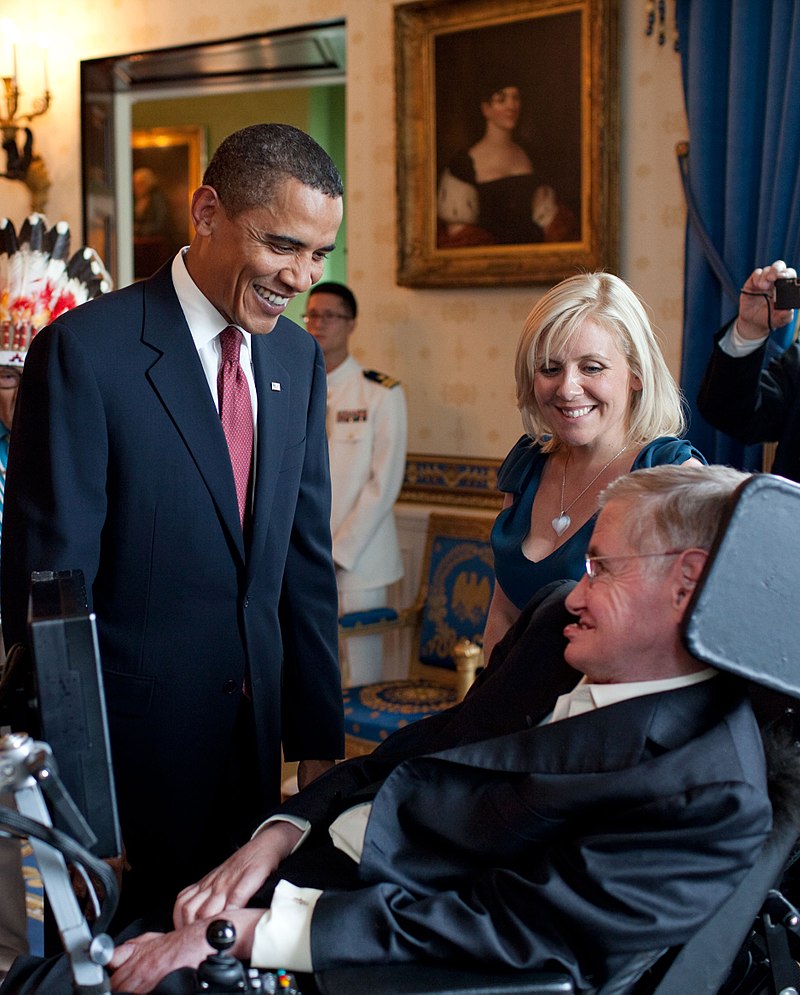
Budding Genius
Stephen William Hawking was born at the height of the Second World War on January 8th, 1942 in Oxford, England. It was exactly 300 years after the death of the father of astronomy, Galileo Galilee. Both of his parents were graduates of Oxford University. His father, Frank, was a medical researcher while his mother, Isobel, worked as a medical research secretary. They were a middle-class family, with both parents being thought of in their community as rather odd ‘brain-boxes.’
Stephen began his schooling at Byron House School in Highgate. The school used a new progressive method of teaching to which Stephen did not take. He stayed here for three years, though, by age eight he still could not read.
At war’s end, Frank was offered a job at the National Institute of Medical Research and the family moved to St. Albans. Here Frank wanted his son to attend prestigious Westminster School. However, Stephen was sick on the day of the entrance exam and he ended up going to nearby St. Albans school.
Stephen was seen as a nerdy outcast at St. Albans. He was small, skinny and he spoke with a lisp that made it hard to understand what he was saying. For the first two years of his time there, he was very much a loner. In the third year he managed to find a small group of like-minded friends. Their extra-curricular activities included going for long bike rides and inventing board games. Stephen proved to be the most inventive and creative of the group who would come up with the rules and organize the state of play.
Stephen had two younger sisters and a brother, who was adopted in 1955. However, his parents showed little interest in domestic affairs. The Hawking house was filled with books and the parents were too busy feeding their minds, often reading books during dinner rather than conversing with their children.
Stephen regularly had his friends over, where they would busy themselves building model planes and electronic devices. From about the age of twelve onwards, their discussions extended from science to religion. They debated the big questions of life among themselves. It was at this time that Stephen began forming his atheistic beliefs.
Stephen’s teachers soon identified a remarkable talent for mathematics and physics. He seemed to intuitively know the answers without having to work through the problem. By the age of fourteen he knew that he wanted to specialize in physics as he felt that it could provide insight into those big questions that he and his friends had been grappling with – where are we from, why are we here and where are we going?
College Bound
At the age of seventeen, Stephen felt ready to take the entrance exam for University College at Oxford. The exam was extremely challenging, consisting of five papers and a general knowledge exam. Hawking came out with a score of 95 percent.
Once again, he found himself as an outsider at this most prestigious place of learning. He had no friends and so kept to himself. Furthermore, he found the lectures to be too basic for him, which led to boredom. He stopped going to many of them and still easily passed his exams. The only lectures that he got any intellectual challenge from were those presented by his physics tutor Robert Berman.
Hawking was well ahead of his fellow students, despite being much younger than many of them. His level of understanding was so advanced that he occasionally made corrections in the text books that he studied. At the end of his second year he easily won the university physics prize.
While at Oxford, Stephen took up the sport of rowing. Rowing was, and still is, a serious business at Oxford and Stephen threw himself into it with complete commitment. He became a coxswain, the person who yells instructions to the rowers. He loved the thrill of guiding his team to success.
It was his involvement in the rowing team which allowed Stephen to break out of his isolation and develop some budding friendships. By the time that his old schoolmates from St. Albans turned up as freshmen they were surprised to discover that the awkward boy that they knew had become a confident young man who had found a comfortable niche for himself at Oxford. In fact, he became so immersed in the social life of his environment that, despite his innate ability, he began to fall back academically.
With his third-year exams approaching quickly, he realized that he was not fully prepared. He decided that his best bet was to focus solely on the theoretical problems that he could solve using his innate skills.
The results of the exam had him teetering between a first and second-class honours degree. He needed it to be first class in order to gain admittance to Cambridge where he planned to begin work on his PhD. The result depended on a final oral exam, which he aced, gaining his first-class honours.
Before heading off to Cambridge, Hawking took a trip to Iran with a friend. He began at Cambridge in October, 1962. While he had been expecting to work directly under the guidance of the famous astronomer Fred Hoyle, this was not the case. He was disappointed to find that his tutor was Dennis Sciama, who he had never heard of. In reality, he was better off under Sciama, who had more time to guide his students than Hoyle would have done.
Hawking socialized in the study of cosmology. It was now that he faced his first real intellectual challenge. He quickly realized that his mathematical knowledge was not deep enough for him to get to grips with the complications of Einstein’s general theory of relativity.
Physical Abnormalities
At about this same time, Hawking began to experience some physical abnormalities. His speech began to slur and he was prone to losing his balance. When he returned home for the 1962 Christmas holidays, his parents were so concerned that they sent him to a specialist. A series of tests were taken and then it was a matter of waiting for the results.
In the meantime, Hawking attended a New Year’s Eve Party where he met a young lady by the name of Jane Wilde. Jane was attracted to the eccentric young intellectual and the two struck an immediate attraction.
Stephen had already returned to Cambridge when the results of his tests came through. He had developed Autotrophic Lateral Sclerosis or ALS. Also known as Lou Gehrig’s Disease, it is a condition in which the body’s cells degenerate, causing paralysis and muscle atrophy. Yet, while the body degenerates, the brain is unaffected. So, Hawking now had the prospect of being trapped within a dysfunctional body.
The prognosis relayed to Hawking was that he had just two years to live. The symptoms that he experienced in the first few months were weakness, stammering while speaking and having trouble swallowing.
Hawking later reflected on his feelings at the time . . .

A disease which can never be healed. I am in the clutches of the disease which is calling me closer to my death. This thought itself used to bring cramps of fear in the stomach. Why have I only been caught by this disease?
Stephen’s doctors and parents advised him to continue his studies at Cambridge. They believed that staying focused on the goal of achieving his PhD. would help him to cope with the pain and frustration of dealing with his failing body. But Hawking struggled with the idea that he was working so hard for a reward that he would probably not live to receive. What was the point is the question that kept dancing around in the back of his brain?
It has been recorded that Hawking went into a deep depression, spending his days drinking and listening to Wagner in his student flat. However, the man himself later denied the assertion. He certainly went into a period of confusion and lack of focus, but he also did his best to continue with his studies. After a year his symptoms had stabilized and his spirits began to pick up. It was also around this time that he picked up his relationship with Jane Wild, who became a great support and encouragement to him. It was she who gave him a glimmer of hope for a brighter future. The two became engaged in October of 1964. Jane had committed herself to looking after Stephen for the rest of his life and they were married on July 14th, 1965.
After two years of living with the disease, Hawking was able to get around on a cane, though his speech was becoming increasingly unintelligible. He was still searching for an area of focus for his thesis. Fred Hoyle had just pronounced his theories on the discovery of the Universe. Hawking believed that Hoyle’s theory was flawed and he publicly challenged them. He then proceeded to wrote his thesis on the topic. It was received well by the cosmology community, establishing him as a player of note.
Growing Recognition
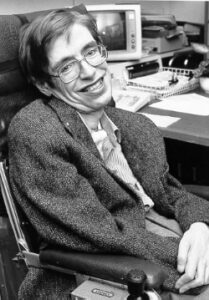
After graduating from Cambridge with a PhD in applied mathematics and theoretical physics, Hawking applied for and received a fellowship at Cambridge’s Gonville and Caius College. The position provided him a secure job, which gave further confidence in the future. Yet, his condition had now reached the stage where he could no longer write, so he had to rely on Jane to record his thoughts.
Hawking’s job at the college required him to supervise students for a few hours each day, providing him with plenty of time to pursue his research studies. He and Jane set up their home in a small house not far from the college. They enjoyed entertaining friends and the house was often filled with dinner guests.
In December of 1965, Hawking was invited to the United States to give an address at a Miami conference. However, his speech was so slurred that a friend had to read the address on his behalf. The speech was very well received, further cementing his growing reputation as an exciting new thinker in the world of cosmology.
While Jane spent a lot of time and effort in caring for her husband, she had given up on her own career. When the couple had met, she was in the middle of a degree in modern languages. She completed the degree in 1967. That year she also gave birth to their first child, Robert. Two more children would follow – Lucy in 1970, and Timothy in 1979.
The birth of his first child was a further motivator for Hawking to look positively toward the future, despite the fact that he had already outlived his doctor’s lifespan prognosis. He now had a family, along with a promising career as a budding genius. In fact, some were even calling him the successor to Einstein.
The Singularity Theory
The turning point in Hawking’s career occurred when he attended a lecture by mathematician Robert Penrose. In the address, Penrose expounded his theory of space-time singularity in the center of a black hole.
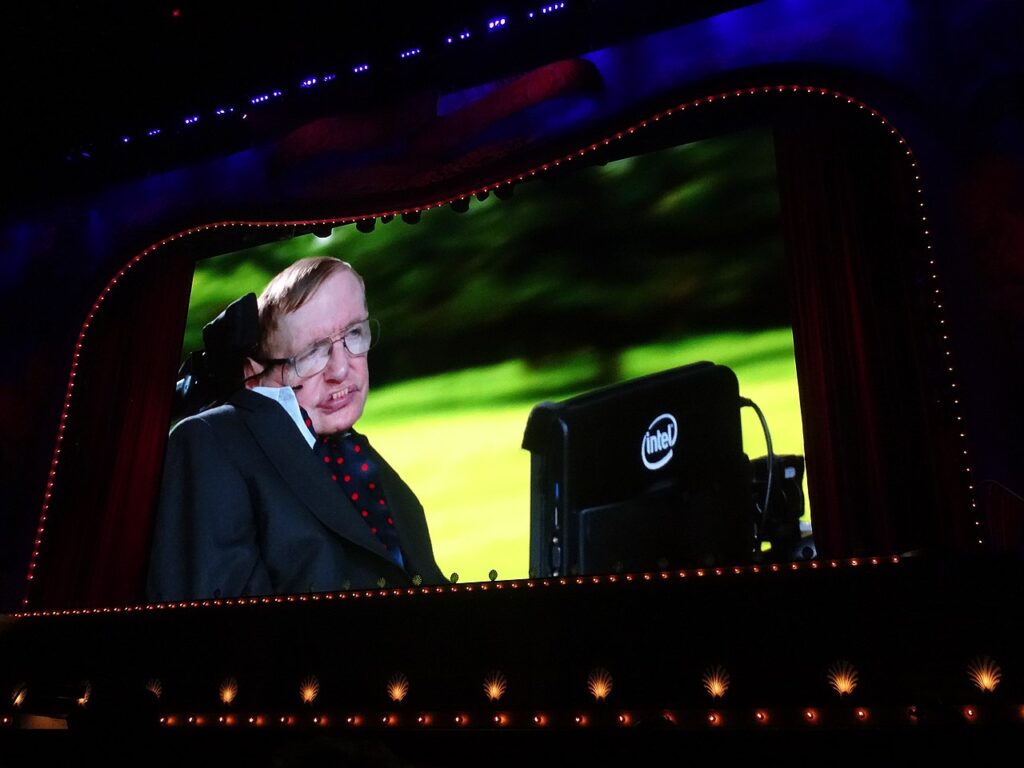
Hawking latched onto the Penrose singularity theory and applied it to the entire universe. If he could prove the mathematics behind it, he knew that this would be a momentous addition to the understanding of the origins of the universe. Mathematics was never Hawking’s strongpoint, so he collaborated with Penrose, who presented his calculations by way of visual representations to help Hawking who was unable to record the calculations himself.
The Big Bang theory was predicated on the idea that the universe was not static, but continually expanding. According to this theory the universe began as a black hole that was held together by gravity. The ‘egg’ at the center of the hole was extremely hot. As it cooled over billions of years it expanded, with the protons, neutrons and electrons forming the stars and galaxies which make up our visible universe. Hawking was not the originator of the theory, but his work, such as the essay ‘Singularities and the Geometry of Spacetime’, gave it a strong underpinning.
Failing Body / Enhanced Mind
By the end of the 1960’s, Hawking’s ALS had deteriorated to the point where he had become wheelchair bound. The intense speed of his mental cognition, however, caused him to move around with maximum speed in his wheelchair. It also caused him to quickly become impatient and irritable to those around him. Despite his raw temperament he became very popular with students and colleagues alike.
In the early 1970’s, Hawking took on the task of reconciling the two opposing theories that had divided physics for years – quantum mechanics and relativity. During his work, he discovered that black holes emit radiation. He published this finding in an article in Nature magazine. There was initial push back but, eventually his finding was accepted and has come to be known as Hawking Radiation.
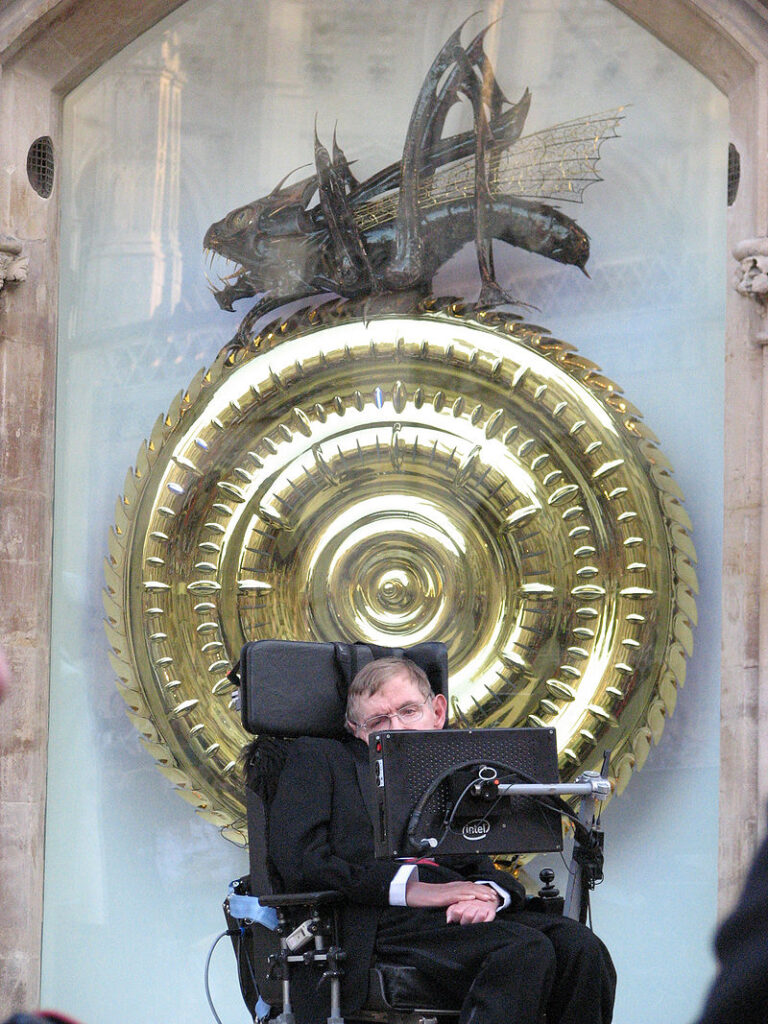
The discovery of black hole radiation was a big deal and it led to publicity beyond the scientific community. Hawking was now receiving general media attention, giving rise to the fame which would see him lauded as the wheelchair genius.
In 1973, Hawking published his first book, The Large-Scale Structure of Space Time. The following year he became, at 32, one of the youngest people to become a fellow of the Royal Society. In 1974, he was also invited to spend a year at the California Institute of Technology. Here he was able to make use of the very best equipment, including the Jet Propulsion Laboratory that is attached to the Institute. During his year in America, he was able to work alongside famous American theoretical physicist, Kip Thorne.
The Hawking family thoroughly enjoyed their year in sunny California. Over the years, Stephen would frequently return to CalTech to make use of their advanced facilities. At the end of their time in the US, the family returned to Cambridge, where they moved into a bigger house on the college grounds. In 1976, a student in residence by the name of Don Page joined the Hawking household. Page would walk Hawking to his office each morning and perform other caretaking jobs.
Around this time, Jane began to feel confined by her life as a mother and wife to a wheelchair bound husband. With Page now on hand to help out with Stephen’s care, she embarked upon a PhD in medieval Spanish poetry. Once she had gained it she began teaching at Cambridge University.
The couple began to experience marital problems from the mid-70’s. One cause of the discord was their wildly divergent religious views. Jane was a committed Christian while Stephen was a confirmed atheist. The relationship remained strained until divorce severed the bond in 1995.
In 1976, Hawking was invited to a number of conferences around the United States, following which he ended up on TV talk shows. Though his speech was difficult to understand, he proved a hit with American audiences.
In 1979, Hawking was appointed Lucasian Professor of Mathematics at Cambridge. This position brought great prestige, with the couple now being the center of the Cambridge social elite. Hawking enjoyed attending concerts and movies. In spite of his physical limitations, he was enjoying his life more than he ever had. Still, he became disappointed at the lack of facilities for handicapped people in the community and became an advocate for disabled facilities.
In 1983, a BBC Horizon documentary gave TV viewers an insight into the private life of the wheelchair genius. This went a long way in promoting his celebrity status. In 1984, he put out feelers to several publishing houses to write a definitive book of his theories for a lay audience. Bantam publishing offered him a $250,000 advance. It took four years to produce the book, which he called A Brief History of Time. It became an instant bestseller and has to date sold more than 10 million copies.
In July, 1985, Hawking was in Geneva when he found himself unable to breathe. After being rushed to the hospital, he underwent tracheotomy surgery. The surgery was a success but the payoff was that he lost his voice.
The challenge was now how to provide Hawking with a way to communicate with the world. It was solved by a computer programmer by the name of Walt Woltosz. His Equalizer program allowed Hawking to select words from a screen which would then be converted to a voice synthesizer.
Personal Problems
From the early ‘80’s onward, Hawking had employed full-time nurses. By the end of that decade he had become alarmingly close to one of them, a woman by the name of Elaine Mason. She was a woman with a dominant and protective personality. In early 1990, Hawking told Jane that he was leaving the family home and moving in with Elaine. Mason was herself married to a family friend at the time.
Hawking instituted divorce proceedings to officially end his marriage to Jane. When the divorce came through in 1995, he and Elaine were married. In the ensuing years there were rumours that Elaine was physically controlling and abusive to her husband. After 11 years the marriage ended. In his autobiography, Hawking referred to his years with Elaine as ‘passionate and tempestuous’.
In the 1990’s, Hawking became interested in time travel. He was of the opinion that the only possible way for time travel to exist would be if it did not alter the status quo. In other words, if a time travel machine could be created in the future, people would only be able to travel back until the time when the machine was created because prior to that time the machine didn’t exist.
Many people rejected Hawking’s ideas on time travel. In order to prove his point in an irreverent way, he decided to hold a party which was open to anyone and served free food and champagne. The catch was that he only advertised the event after it had occurred, so that only time travellers would be aware of it. Unsurprisingly, no one turned up.
In the early 2000’s, Hawking focused on publishing more popular books, starting with 2001’s The Universe in a Nutshell and in 2005, he put out A Briefer History of Time, both of which were bestsellers. By then his iconic status was well established, being cemented with appearances on The Simpsons and Star Trek- The Next Generation.
The End
By 2005, Hawking’s condition had deteriorated to the extent that he could only control his speech controls with movement of his cheek muscles. From 2009, he could no longer move his electric wheelchair himself and his breathing became increasingly difficult.
The end came peacefully on the morning of March 14, 2018. It was the 139th Anniversary of the birth of Albert Einstein.



